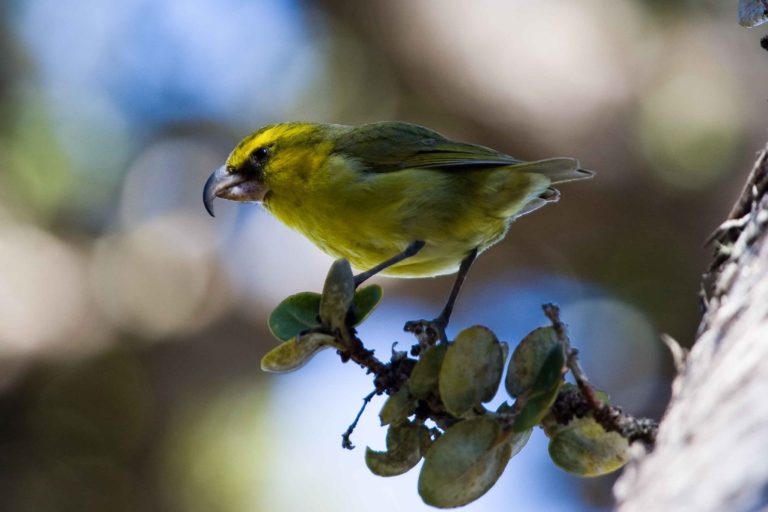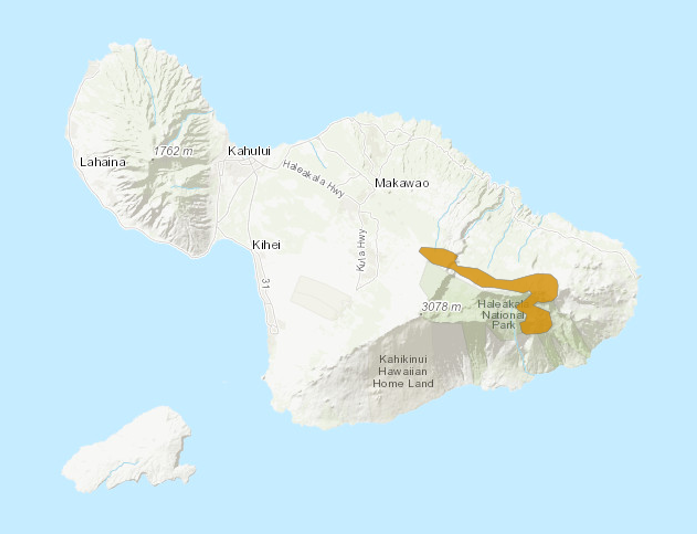Birdfinding.info ⇒ Critically endangered and declining, but still present in tiny numbers, at least through the 2010s, at the Waikamoi Preserve on the northern slope of Mount Haleakala. Although the two sites are very close, it has very rarely been found in the Hosmer Grove. Originally discovered by collectors in the 1890s, then remained unknown until rediscoveries in 1950 and more definitively in 1967.
Maui Parrotbill
Pseudonestor xanthophrys
Endemic to Maui; critically endangered.
Confined to native forests on the northern and eastern slopes of Mount Haleakala in the range of 1,200 to 2,350 m (mainly 1,500 to 2,100 m) elevation in an effective habitat area of about 40 square kilometers.
The lower elevation limit is largely determined by the presence of malarial mosquitoes, as it also occurred in the lowlands before the mosquitoes arrived on Maui.
In 2019 the total population was estimated at between 44 and 312 individuals, having declined from previous estimate of 380 to 800, which had been more or less stable from the 1970s to the 2000s. An attempted introduction to the Hakula Forest Reserve on the southern slope of Haleakala was aborted as most of the transplanted birds quickly died of malaria.
Identification
A plump, olive honeycreeper with a pale eyebrow, a blackish mask, and an outsized, parrotlike bill.
Adult male develops a golden flush, strongest on the face, but also on the underparts and wings.
Females and immatures are plainer, more gray-olive overall, but also have a variable golden flush on the underparts.

Maui Parrotbill. (Waikamoi Preserve, Maui, Hawaii; June 8, 2008.) © Michael Walther
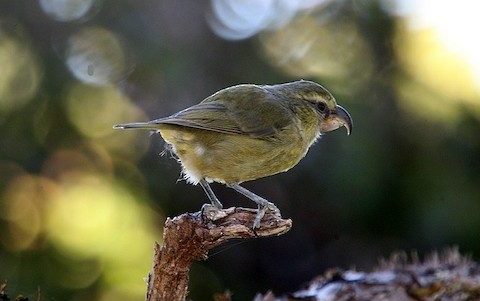
Maui Parrotbill. (Waikamoi Preserve, Maui, Hawaii; June 8, 2008.) © Michael Walther

Maui Parrotbill. (Waikamoi Preserve, Maui, Hawaii; September 8, 2018.) © Conor Best
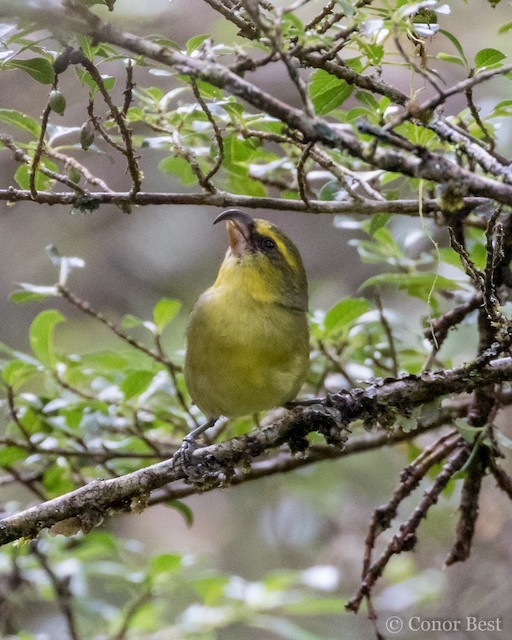
Maui Parrotbill. (Waikamoi Preserve, Maui, Hawaii; September 8, 2018.) © Conor Best
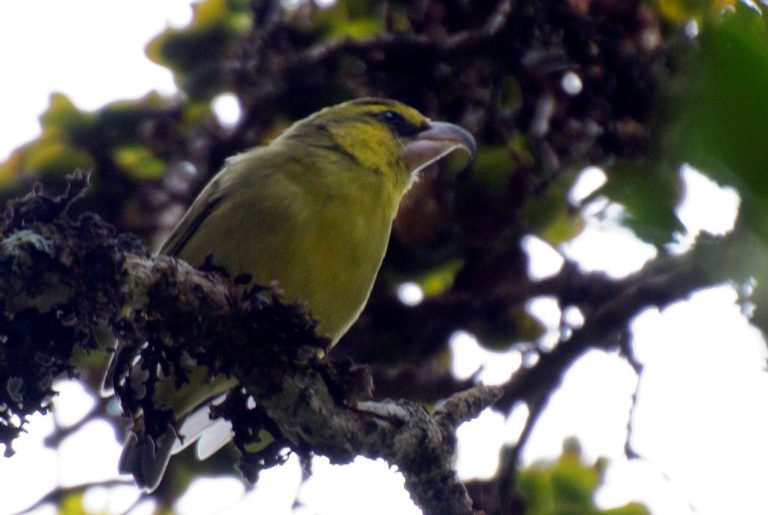
Maui Parrotbill. (Waikamoi Preserve, Maui, Hawaii; August 4, 2012.) © Joseph Leibrecht
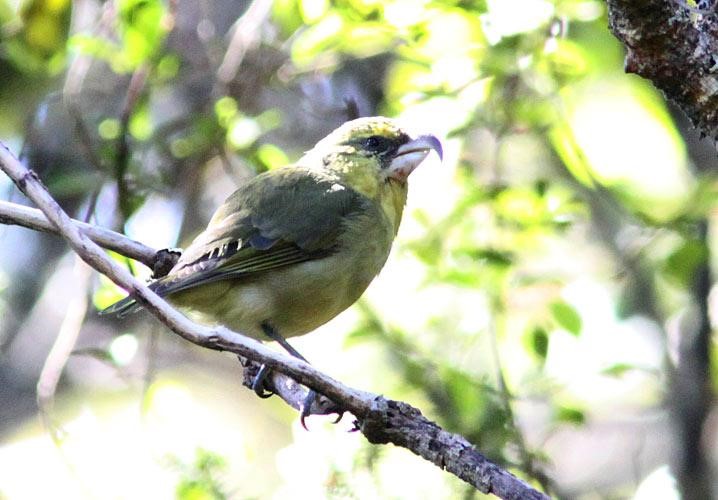
Maui Parrotbill. (Waikamoi Preserve, Maui, Hawaii; July 27 2009.) © Aleix Comas

Maui Parrotbill. (Waikamoi Preserve, Maui, Hawaii; March 11, 2017.) © Alex Lin-Moore
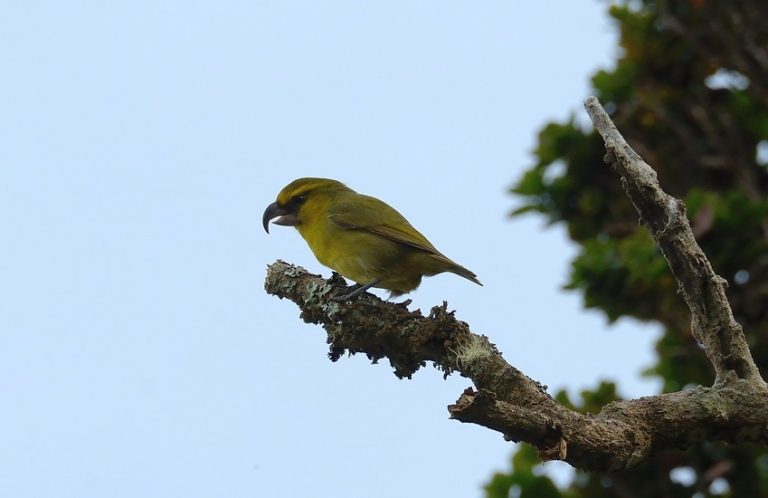
Maui Parrotbill. (Waikamoi Preserve, Maui, Hawaii; November 6, 2014.) © Jim Denny
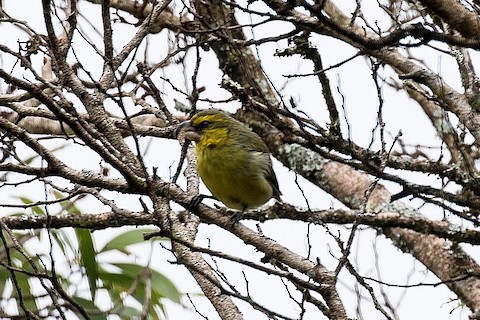
Maui Parrotbill. (Waikamoi Preserve, Maui, Hawaii; June 9, 2018.) © Scott Nishiki

Maui Parrotbill. (Hanawi Natural Area Reserve, Maui, Hawaii; May 6, 2009.) © Elliot Schunke
Voice. Song is decribed as “a cascade of warbles twee-twee-twee-twee-twee or chewEE-chewEE-chewEE-chewEE-chewEE with a distinctive plaintive quality.” (Pratt 2005)
One of its calls is a crisp, rising too-wheet!: Pu’u’alae, Maui, Hawaii, April 11, 1979. © Tim Burr
Notes
Monotypic species. The native Hawaiian name is Kiwikiu.
IUCN Red List Status: Critically Endangered.
References
BirdLife International. 2016. Pseudonestor xanthophrys. The IUCN Red List of Threatened Species 2016: e.T22720753A94681687. https://dx.doi.org/10.2305/IUCN.UK.2016-3.RLTS.T22720753A94681687.en. (Accessed May 9, 2020.)
eBird. 2020. eBird: An online database of bird distribution and abundance. Cornell Lab of Ornithology, Ithaca, N.Y. http://www.ebird.org. (Accessed May 9, 2020.)
Osher, W. 2019. Nine Rare Kiwikiu Birds Die Out of 13 Translocated at Maui’s Nakula Forest. Maui Now (November 12, 2019), https://mauinow.com/2019/11/12/nine-rare-kiwikiu-birds-die-out-of-13-translocated-at-mauis-nakula-forest/.
Pratt, H.D. 2005. The Hawaiian Honeycreepers: Drepanidinae. Oxford University Press.
Pratt, H.D. 2020. Maui Parrotbill (Pseudonestor xanthophrys). In Handbook of the Birds of the World Alive (J. del Hoyo, A. Elliott, J. Sargatal, D.A. Christie, and E. de Juana, eds.). Lynx Edicions, Barcelona. https://www.hbw.com/node/61449. (Accessed May 9, 2020.)
Pyle, R.L., and P. Pyle. 2017. The Birds of the Hawaiian Islands: Occurrence, History, Distribution, and Status. Version 2 (January 1, 2017). http://hbs.bishopmuseum.org/birds/rlp-monograph/. B.P. Bishop Museum, Honolulu, Hawaii.
